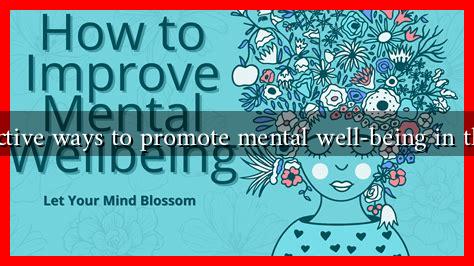-
Table of Contents
- Effective Ways to Promote Mental Well-Being in the Community
- Understanding Mental Well-Being
- Community-Based Approaches to Mental Well-Being
- Case Studies: Successful Community Initiatives
- Statistics Highlighting the Need for Community Mental Health Initiatives
- Conclusion: Building a Supportive Community
Effective Ways to Promote Mental Well-Being in the Community
Mental well-being is a crucial aspect of overall health that often goes overlooked in community settings. As awareness of mental health issues grows, it becomes increasingly important to implement effective strategies that promote mental well-being. This article explores various methods to enhance mental health within communities, supported by research, case studies, and practical examples.
Understanding Mental Well-Being
Mental well-being encompasses emotional, psychological, and social health. It affects how individuals think, feel, and act, influencing how they handle stress, relate to others, and make choices. According to the World Health Organization (WHO), mental health is more than just the absence of mental disorders; it is a state of well-being in which every individual realizes their potential, can cope with the normal stresses of life, and can contribute to their community.
Community-Based Approaches to Mental Well-Being
Communities play a vital role in supporting mental health. Here are some effective strategies that can be implemented:
- Awareness Campaigns: Educating the public about mental health issues can reduce stigma and encourage individuals to seek help. Campaigns can include workshops, seminars, and social media outreach.
- Support Groups: Establishing peer-led support groups can provide a safe space for individuals to share their experiences and feelings. These groups foster a sense of belonging and community.
- Access to Resources: Providing easy access to mental health resources, such as counseling services and hotlines, is essential. Communities can partner with local mental health organizations to offer these services.
- Physical Activity Programs: Regular physical activity is linked to improved mental health. Communities can organize group exercise classes, walking clubs, or sports leagues to promote physical well-being.
- Mindfulness and Meditation Workshops: Teaching mindfulness techniques can help individuals manage stress and anxiety. Workshops can be held in community centers or schools.
Case Studies: Successful Community Initiatives
Several communities have successfully implemented programs that promote mental well-being:
- Project Semicolon: This initiative encourages individuals to share their mental health struggles and stories of hope. By using the semicolon as a symbol, it promotes the message that one’s story isn’t over, fostering a supportive community.
- Time to Change (UK): This campaign aims to change the way people think and act about mental health. Through various media and community events, it has successfully reduced stigma and encouraged open conversations about mental health.
- Mindfulness in Schools: Programs like Mindfulness in Schools Project (MiSP) have been implemented in various educational institutions, teaching children mindfulness techniques to help them manage stress and improve focus.
Statistics Highlighting the Need for Community Mental Health Initiatives
Understanding the prevalence of mental health issues can underscore the importance of community initiatives:
- According to the National Institute of Mental Health, approximately 1 in 5 adults in the U.S. experience mental illness each year.
- The WHO reports that depression is the leading cause of disability worldwide, affecting over 264 million people.
- Research indicates that community support can significantly reduce the risk of mental health issues, with studies showing that social connections can improve mental health outcomes.
Conclusion: Building a Supportive Community
Promoting mental well-being in the community is a multifaceted approach that requires collaboration, education, and resources. By implementing awareness campaigns, support groups, and accessible resources, communities can create an environment that fosters mental health. Successful case studies demonstrate that these initiatives can lead to significant improvements in mental well-being. As we continue to prioritize mental health, it is essential to remember that every effort counts in building a supportive community.
For more information on mental health resources and initiatives, visit NAMI (National Alliance on Mental Illness).

